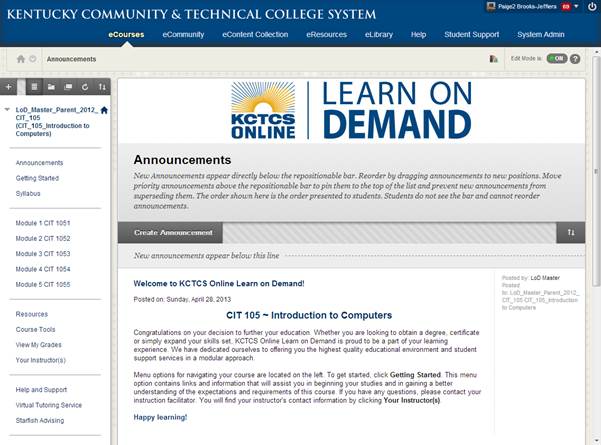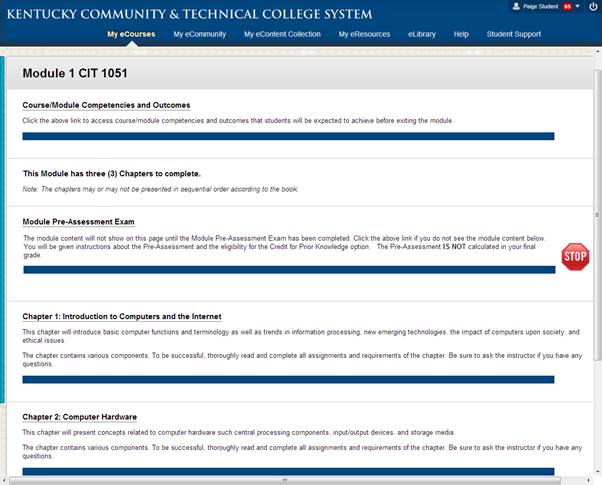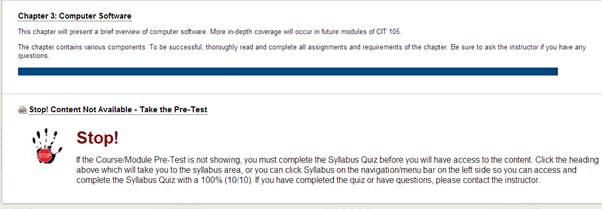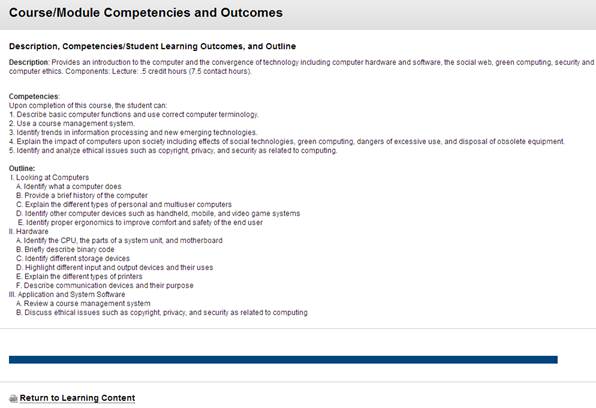Key Takeaways
- In its existing program, the Kentucky Community and Technical College System offers students enhanced schedule flexibility and modular courses that they can start at any time.
- To achieve both higher student retention and faster degree completion, the new Direct2Degree model builds on this existing flexibility and lets students take one full-time course at a time.
- Students in competency-based environments need financial aid that mimics their progress, not a college calendar; the KCTCS is currently assessing alternative financial assistance models that better meet these needs.
- Direct2Degree is designed to utilize a monthly subscription model for tuition because the faster students move toward a degree, the more money they save.
In 1997, Kentucky Governor Paul Patton championed a legislative mandate to reach the national average in educational attainment by 2020 [http://www.lrc.state.ky.us/recarch/97ss/HB1.htm]; successive governors have continued to embrace the mandate. Currently, 29 percent of Kentuckians ages 25–64 have a college degree, compared to a national average of 38 percent. Going even further, President Obama set a goal that the nation should have the highest proportion of college graduates in the world by the year 2020. The National Center for Higher Education Management Systems (NCHEMS) estimates that the state needs 372,272 additional degrees/certificates — or a 5 percent annual increase — to meet Lumina's Big Goal of having 60 percent of Americans possess a college credential by 2025. To achieve these ambitious goals and to break the mold for how to deliver a college degree, KCTCS has proposed Direct2Degree.
Funded through a Wave III-B Next Generation Learning Challenge grant, the Direct2Degree (D2D) program capitalizes on 10 years' experience with online learning in the Kentucky Community and Technical College System (KCTCS). D2D's goal is to leverage the existing competency-based Learn-on-Demand (LoD) course model to boost the capacity and completion rates for KCTCS credentials. Using a linear sequence of 81 modules that lead to a transferrable associate degree, coupled with a specified course list, D2D will reduce credits lost to irrelevant or dropped courses, increase student performance, and protect degree affordability.
KCTCS Chancellor Jay Box compares D2D to LoD (1:00 minute).
Enhancing Student Success
For students, college is a challenging and often chaotic environment. Study and class time often suffer as a result, leading to poor grades, flagging motivation, and outright departure. To help address this, KCTCS provides enhanced schedule flexibility through its LoD program, which offers modular courses that students can begin 24/7/365. These courses are based on, and limited to, a 15-week term. Figure 1 shows the first page of an entry-level LoD computing course.

Figure 1. Welcome/course entry page for an LoD course on computers
Modularizing courses, defining explicit competencies, and developing correlated pre- and post-assessments to determine mastery are a good start; however, they are insufficient to realize the full potential for student learning and cost reduction. To address this shortcoming, KCTCS's D2D program adds other specific innovations to dramatically increase student success and affordability.
Because the LoD courses are designed for a 15-week duration, students must enroll in and manage at least four concurrent courses each term to be considered "full-time." In contrast, with D2D, students can take one course at a time, full-time, in a block-style format; the hypothesis is that doing so will increase both success and retention.
Chancellor Box describes the D2D single-course delivery model (2:23 minutes).
Building on research that indicates a positive learning impact from course redesign,1 personalized learning approaches,2 and student preferences for desirable course length,3 the D2D format will provide online what many students already experience during the summer and in intersessions — accelerated and concentrated enrollment in only one course at a time.
For the D2D program, KCTCS will use 20 LoD courses consisting of 81 discrete modules and will reconfigure course delivery. As figure 2 shows, each module includes a pre-test; knowledge, skills, and attitude learning activities; and a post-test. Students enter the D2D program in module 1 and proceed along a linear-sequential path to module 81 and graduation. Students can proceed each term and progress as quickly as they choose as permitted by the linear-sequential model. This model also provides additional benefits and possibilities. By taking one course at a time, students — especially those with low-entry skills — can concentrate fully on one topic and thereby potentially increase their success.


Figure 2. Entry page for the first module
We're currently defining courses and the course delivery sequence for D2D. Both faculty and staff development are occurring for the redesign of initial courses into direct assessment, competency-based modules. Intensive planning has gone into creating new tuition and cost-delivery models in collaboration with the NCHEMS. Efforts are also underway to seek permission from the U.S. Department of Education to restructure the financial aid award based on this direct assessment, competency-based model. We plan to offer our initial courses/modules for enrollment in fall 2013.
Elizabeth Dalton, KCTS Direct2Degree instructional designer, describes the course redesign process (1:38 minutes).
Challenges and Goals
At its heart, D2D seeks improved affordability for students by redesigning the delivery of higher education content. The most viable path to improved student affordability is to decrease a student's time to degree by enabling and rewarding early degree completion. Modular delivery coupled with competency testing (figure 3) will allow students to progress toward completing their degree at their own pace and will reduce delivery costs.

Figure 3. Competencies tested for this module
Financial Aid
The self-paced, sequential delivery model uses a monthly subscription rather than the traditional credit-hour tuition assessment. Guided by NCHEMS's cost measurement and management expertise, KCTCS and the Southern Region Education Board (SREB) are constructing a cost-analysis model to test different tuition, student aid, and college savings scenarios. When complete, this model will offer a useful, sharable tool for other colleges to test and optimize the cost, price, and subsidy balance of their own competency-based courses and programs.
Continuous progress by students in an alternative format requires reliable financial aid; the D2D model presents challenges to the traditional, semester-based financial aid award. Students learning in a competency-based environment need grants and loans that mimic their progress — not a college calendar. KCTCS will assess and implement alternative financial assistance models, such as Western Governors University's six-month extended term model, as well as test the potential of the direct assessment model provided in federal regulations, which is as yet untried by any U.S. college.
Fiscal Implications
Another significant challenge is assessing an accelerated model's potential cost savings for students and colleges. The Delta Cost Project, an independent nonprofit organization, seeks to improve college affordability by controlling costs and creating analytic tools to improve productivity. The project believes that college costs can be contained without sacrificing access or educational quality by better using data to inform strategic decision making. For example, the model will incorporate an analysis of factors to help identify anticipated student pace through the model. These data will include elements such as ACT scores, historical course difficulty, and course retention rates. Currently, Delta Cost Project calculations are based on a fixed-time definition of a credit hour; they are not designed to show the fiscal implications of reduced time to mastery and degree.
Several questions remain when comparing D2D and traditional course delivery models:
- How might accelerated completion impact expenses and revenues?
- What might the cost differences be — for content and course development, content delivery, and support services — when different combinations of activities are offered?
- What resources (particularly faculty and staff) will be required for these different activities?
- How will the scale (number of students enrolled per section or course) impact costs and revenue given the different times to completion?
Understanding the relationship, balance, and optimization of time-based savings and cost reductions is a critical issue; the D2D design process will address this by providing actual data that can serve as factors in real-time and future cost/revenue modeling.
Given these issues, we'll focus our assessment of cost savings on two areas:
- Savings realized by students, who will be assessed on a self-paced, monthly subscription model rather than traditional credit-hour tuition assessments
- Institutional cost avoidance that results from a more efficient online delivery model, which increases student retention and accelerates self-paced degree completion
The D2D program also offers the promise for more efficient staffing due to the program's linear nature.
Potential Impact
The KCTCS D2D program challenges almost every aspect of community college degree pursuit. It addresses the "iron triangle" of cost, access, and quality in a way that has never been attempted in American public higher education, and thus has the potential to transform traditional course-taking patterns and financial aid models, while also increasing student success.
The D2D program will test the virtually unknown impact of student enrollment loads by offering students a one-course-at-a time format coupled with the flexibility to move at their own pace under the guidance of an instructor and within the course parameters. It also provides measurable financial incentives for students to move quickly to complete their academic degrees.
D2D will utilize numerous adaptive learning opportunities, which provide individualized learning materials via computer technology according to students' learning needs based on their learning style. D2D ensures that course quality will meet or exceed other forms of delivery while providing verifiable levels of student learning assessments. Finally, the D2D program will be both scalable and informative. While providing useful data on the effectiveness of this program design to accelerate student completion, it can also help make the program application scalable for other online programs.
Breaking new ground is always challenging and exciting. The D2D program should add greatly to the existing body of knowledge, offering new information on how to help students achieve results, reach their goals, and complete degrees while controlling the costs of their education.
- Benjamin S. Bloom, "The 2 Sigma Problem: The Search for Methods of Group Instruction as One-to-One Tutoring," Educational Researcher, vol. 13, no. 6 (1984), pp. 4-16; Carol A. Twigg, "Increasing Success for Underserved Students: Redesigning Introductory Courses," National Center for Academic Transformation (2005); and Marsha Lovett, Oded Meyer, and Candace Thille, "The Open Learning Initiative: Measuring the Effectiveness of the OLI Statistics Course in Accelerating Student Learning," Journal of Interactive Media in Education (May 2008).
- Mary Ann Wolf, "Innovate to Educate: System [re]Design for Personalized Learning [http://siia.net/pli/presentations/PerLearnPaper.pdf]—A Report from the 2010 Symposium," Software and Information Industry Association (2010).
- Jim Flowers, "Online Learning Needs in Technology Education," Journal of Technology Education, vol. 13, no. 1 (2001); and David Diaz and Ryan Cartnal, "Term Length as an Indicator of Attrition in Online Learning," Innovate, vol. 2, no. 5 (2006).
© 2013 James E. Selbe and Sandy Cook. The text of this EDUCAUSE Review Online article is licensed under the Creative Commons Attribution-Noncommercial-No derivative works 3.0 license.
